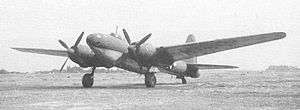Tachikawa Ki-74
| Ki-74 | |
|---|---|
 | |
| Role | Long Range Reconnaissance Bomber |
| Manufacturer | Tachikawa Aircraft Company Ltd |
| Designer | Jiro Tanaka (in the final stage of the development from the summer of 1944 until August 1945)[1][2][3] |
| First flight | March 1944 |
| Primary user | Imperial Japanese Army Air Force |
| Number built | 16 |
|
| |
The Tachikawa Ki-74 was a Japanese experimental long-range reconnaissance bomber of World War II. A twin-engine, mid-wing monoplane, it was developed for the Imperial Japanese Army Air Force but did not enter service.
Development
Though already conceived in 1939[4] as a long-range reconnaissance aircraft capable of reaching west of Lake Baikal when operating from bases in Manchukuo (Manchuria), the prototype Ki-74 (designated as A-26 by Tachikawa) only first flew as late as in March 1944; it was powered by two 1,641 kW (2,201 hp) Mitsubishi Ha-211-I [Ha-43-I] radial engines. The following two prototypes were powered by the turbo-supercharged Mitsubishi Ha-211-I Ru [Ha-43-II], but as these experienced teething troubles, the following thirteen pre-production machines substituted the Ha-211 Ru engine for the lower-powered, but more reliable, turbo-supercharged Mitsubishi Ha-104 Ru (Army Type 4 1,900 hp Air Cooled Radial).[5]
Operational history
The Ki-74 did not see operational service. Nevertheless, the Allies knew of its existence and assigned the type the codename "Patsy" after it was discovered that it was a bomber, not a fighter. Previously it had the code name "Pat" in Allied Intelligence.[6]
Specifications (Ki-74)
Data from The Imperial Japanese Secret Weapons Museum ;[7] Japanese Aircraft of the Pacific War[6]
General characteristics
- Crew: 5
- Capacity: 9,200 kg (20,300 lb)
- Length: 17.65 m (57 ft 11 in)
- Wingspan: 18.6 m (61 ft 0 in)
- Height: 5.1 m (16 ft 9 in)
- Wing area: 80 m2 (860 sq ft)
- Empty weight: 10,200 kg (22,487 lb)
- Gross weight: 19,400 kg (42,770 lb)
- Powerplant: 2 × Mitsubishi Ha104 Ru turbo-supercharged 18-cylinder air-cooled radial piston engines, 1,500 kW (2,000 hp) each
Performance
- Maximum speed: 570 km/h (354 mph; 308 kn)
- Cruising speed: 400 km/h (249 mph; 216 kn)
- Range: 8,000 km (4,971 mi; 4,320 nmi)
- Service ceiling: 12,000 m (39,370 ft)
- Wing loading: 242.5 kg/m2 (49.7 lb/sq ft)
- Power/mass: 0.154 kW/kg (0.093 hp/lb; 0.206 hp/kg)
Armament
- 1 x 12.7 mm (0.500 in) Ho-103 machine gun
- 1,000 kg (2,200 lb) bomb load
See also
- Aircraft of comparable role, configuration and era
References
Notes
- ↑ Carmakers owe success to warplanes – Military's brightest aircraft designers created Japan's automotive powers The Japan Times, August 13, 2005
- ↑ The History and the Biography of Jiro Tanaka (Detailed PDF document attached) (Japanese) – Japan Automotive Hall of Fame
- ↑ From the Ki-74 to the Tama Electric Vehicles and the Prince Vehicles – Interview of Jiro Tanaka on Nov. 22, 1996 (Japanese) – The Society of Automotive Engineers of Japan (JSAE)
- ↑ Francillon 1979, p. 259.
- ↑ Francillon 1979, pp. 260–261.
- 1 2 Francillon 1979, p. 261.
- ↑ "The Imperial Japanese Secret Weapons Museum". Archived from the original on October 27, 2009.
Bibliography
- Francillon, René J. (1979). Japanese Aircraft of the Pacific War. Putnam Aeronautical. ISBN 0-370-30251-6.
External links
| Wikimedia Commons has media related to Tachikawa Ki-74. |
- Ki-74 Patsy at www.hikotai.net
- Ki-74 Patsy at ww2drawings.jexiste.fr
- Ki-74 Patsy at The Imperial Japanese Secret Weapons Museum